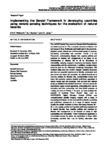Implementing the Sendai framework in developing countries using remote sensing techniques for the evaluation of natural hazards
| dc.contributor.author | Whitworth, MRZ | |
| dc.contributor.author | Boulton, Sarah | |
| dc.contributor.author | Jones, J | |
| dc.date.accessioned | 2020-06-15T08:43:14Z | |
| dc.date.issued | 2020-06-06 | |
| dc.identifier.issn | 1344-9656 | |
| dc.identifier.uri | http://hdl.handle.net/10026.1/15757 | |
| dc.description.abstract |
The UNISDR Sendai Framework for Disaster Risk Reduction has the stated outcome for “The substantial reduction of disaster risk and losses in lives, livelihoods and health and in the economic, physical, social, cultural and environmental assets of persons, businesses, communities and countries”. Priority 1 of the Framework, understanding disaster risk, requires policies and practices for disaster risk management to be based on an understanding of disaster risk in all its dimensions of vulnerability, capacity, exposure of persons and assets, hazard characteristics and the environment. In addition, complementary schemes such as the Millennium Challenge Corporation, 100 Resilient Cities and the UNISDR Disaster Resilient Scorecard also have an essential requirement to identify, understand, and use current and future risk scenarios. As natural hazards are a common catalyst for disaster risk, understanding current and future risk scenarios requires detailed preliminary appraisals of natural hazard and risk scenarios, both at local and national levels, as detailed in the Sendai Framework. However, due to the data-intense nature of such appraisals, undertaking them can be expensive and time consuming, and thus hinder progress at meeting the aims of Priority 1. As such, we here evaluate the potential of available “Open Source” data, such as ASTER/SRTM Digital Elevation Models (DEMs) and Landsat/Sentinel satellite imagery, coupled with a range of processing techniques, for the cost and time effective screening and preliminary assessment of a range of natural hazards. Despite the spatial resolution of these data being between 30 - 50 m, the outputs provide an important preliminary assessment of natural hazards, thus enabling policies and practices for disaster risk management to be focused on areas of high susceptibility and vulnerability. These methods are applicable to communities across the globe, but particularly to those within developing countries that may be lacking alternative data sources. | |
| dc.format.extent | 113-122 | |
| dc.language.iso | en | |
| dc.publisher | International Association of Lowland Technology | |
| dc.title | Implementing the Sendai framework in developing countries using remote sensing techniques for the evaluation of natural hazards | |
| dc.type | journal-article | |
| dc.type | Journal Article | |
| plymouth.issue | 1 | |
| plymouth.volume | 22 | |
| plymouth.publisher-url | http://cot.unhas.ac.id/journals/index.php/ialt_lti/article/view/797 | |
| plymouth.publication-status | Published | |
| plymouth.journal | Lowland Technology International | |
| plymouth.organisational-group | /Plymouth | |
| plymouth.organisational-group | /Plymouth/Faculty of Science and Engineering | |
| plymouth.organisational-group | /Plymouth/Faculty of Science and Engineering/School of Geography, Earth and Environmental Sciences | |
| plymouth.organisational-group | /Plymouth/REF 2021 Researchers by UoA | |
| plymouth.organisational-group | /Plymouth/REF 2021 Researchers by UoA/UoA07 Earth Systems and Environmental Sciences | |
| plymouth.organisational-group | /Plymouth/Users by role | |
| plymouth.organisational-group | /Plymouth/Users by role/Academics | |
| dcterms.dateAccepted | 2020-03-15 | |
| dc.rights.embargodate | 2020-6-20 | |
| dc.rights.embargoperiod | Not known | |
| rioxxterms.version | Version of Record | |
| rioxxterms.licenseref.uri | http://www.rioxx.net/licenses/all-rights-reserved | |
| rioxxterms.licenseref.startdate | 2020-06-06 | |
| rioxxterms.type | Journal Article/Review |


